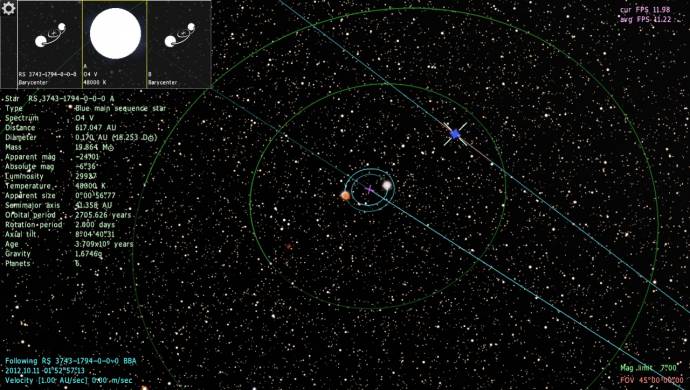|
Space anomalies
|
|
| HarbingerDawn | Date: Friday, 13.07.2012, 09:48 | Message # 16 |
 Cosmic Curator
Group: Administrators
 United States
United States
Messages: 8717
Status: Offline
| I found a binary gas giant in which each component was nearly the same mass as the other! Still considered as "planet-moon" by the engine, but it is anything but.


Each had a mass of between 0.6 and 0.7 Jupiter masses.
RS 8403-196-8-9440274-91 6-6.1
All forum users, please read this!
My SE mods and addons
Phenom II X6 1090T 3.2 GHz, 16 GB DDR3 RAM, GTX 970 3584 MB VRAM
|
| |
| |
| smjjames | Date: Sunday, 07.10.2012, 02:29 | Message # 17 |
|
World Builder
Group: Users
 United States
United States
Messages: 913
Status: Offline
| Quote (SpaceEngineer) 4) Planet or moon with high axial tilt.
There is a 20% chance for a planet to have obliquity of more than 40° and even more than 90° (retrograde rotation). In reality this is caused by a huge planetary collision when the system was formed, or some other unknown process. Example: Venus, Uranus. Moons can have high axial tilt, only if it rotates far away from parent planet or if the system is young, so tidal forces have no time to stop its rotation.
What's the current chance since it seems like it's a lot more than 20%?

|
| |
| |
| smjjames | Date: Sunday, 07.10.2012, 03:06 | Message # 18 |
|
World Builder
Group: Users
 United States
United States
Messages: 913
Status: Offline
| (sorry for double post since we can't edit posts right now)
Or maybe it's because I misunderstood the high axial tilt numbers beyond 180 as crazy axial tilts and not as retrograde....

|
| |
| |
| Toty | Date: Sunday, 07.10.2012, 20:57 | Message # 19 |
 Explorer
Group: SE team
 Spain
Spain
Messages: 158
Status: Offline
| Octuple star system. Damn!
RS 8403-31-6-260861-94
|
| |
| |
| HarbingerDawn | Date: Sunday, 07.10.2012, 21:05 | Message # 20 |
 Cosmic Curator
Group: Administrators
 United States
United States
Messages: 8717
Status: Offline
| Quote (Toty) Octuple star system. Damn!
WOW!  F, G, and K main sequence stars, in addition to brown dwarfs and a white dwarf, all in the same system! F, G, and K main sequence stars, in addition to brown dwarfs and a white dwarf, all in the same system!
Spectacular find!
All forum users, please read this!
My SE mods and addons
Phenom II X6 1090T 3.2 GHz, 16 GB DDR3 RAM, GTX 970 3584 MB VRAM
|
| |
| |
| smjjames | Date: Sunday, 07.10.2012, 21:35 | Message # 21 |
|
World Builder
Group: Users
 United States
United States
Messages: 913
Status: Offline
| Quote (Toty) Octuple star system. Damn!
RS 8403-31-6-260861-94
WOW! Post up some screenshots in the image dump thread, I bet they'd look awesome. 

Edited by smjjames - Sunday, 07.10.2012, 21:43 |
| |
| |
| Joey_Penguin | Date: Monday, 08.10.2012, 02:49 | Message # 22 |
 Pioneer
Group: Users
 United States
United States
Messages: 311
Status: Offline
| Quote Yes, comets require a particle system.
Can't you just do what Celestia did with comet tails? They seemed realistic enough.
Careful. The PLATT Collective has spurs.
|
| |
| |
| HarbingerDawn | Date: Monday, 08.10.2012, 02:58 | Message # 23 |
 Cosmic Curator
Group: Administrators
 United States
United States
Messages: 8717
Status: Offline
| Quote (Joey_Penguin) Can't you just do what Celestia did with comet tails? They seemed realistic enough.
I wouldn't say that they were all that realistic, but they were nice to look at, and something like that would be a great interim solution for comet effects in SE. I'd rather have simple comets than no comets at all.
All forum users, please read this!
My SE mods and addons
Phenom II X6 1090T 3.2 GHz, 16 GB DDR3 RAM, GTX 970 3584 MB VRAM
|
| |
| |
| smjjames | Date: Thursday, 11.10.2012, 02:57 | Message # 24 |
|
World Builder
Group: Users
 United States
United States
Messages: 913
Status: Offline
| 3.7 billion year old blue main sequence star, heh. I know it's a quirk of the way SE works because it doesn't assign different ages or check to see whether 3 billion years is too old for a blue star. It's possible that it had a recent merger with a companion star, not sure about that high mass though....


Edited by smjjames - Thursday, 11.10.2012, 02:58 |
| |
| |
| SpaceEngineer | Date: Thursday, 11.10.2012, 15:10 | Message # 25 |
 Author of Space Engine
Group: Administrators
 Russian Federation
Russian Federation
Messages: 4800
Status: Offline
| Quote (smjjames) 3.7 billion year old blue main sequence star, heh. I know it's a quirk of the way SE works because it doesn't assign different ages or check to see whether 3 billion years is too old for a blue star. It's possible that it had a recent merger with a companion star, not sure about that high mass though....
This is a bug, thanks for finding it! I've fixed it, now the blue star and overall system have an age of 1.64 million years.

|
| |
| |
| smjjames | Date: Thursday, 11.10.2012, 15:20 | Message # 26 |
|
World Builder
Group: Users
 United States
United States
Messages: 913
Status: Offline
| Quote (SpaceEngineer)
This is a bug, thanks for finding it! I've fixed it, now the blue star and overall system have an age of 1.64 million years.
You're welcome.  I usually see blue stars that are a couple million years old, so this one was a total oddball. I usually see blue stars that are a couple million years old, so this one was a total oddball.
There are also giants that are some billions of years old, but that is a much less clear area since I'm not sure the typical lifespan. Plus yesterday I found a Yellow Giant that was something like 1.2 diameter and 1.5 mass sol which was a few billion years old (and I don't think it was part of a binary), so they apparently vary in mass. I don't think that is actually a giant star, maybe a subgiant.

|
| |
| |
| HarbingerDawn | Date: Thursday, 11.10.2012, 16:33 | Message # 27 |
 Cosmic Curator
Group: Administrators
 United States
United States
Messages: 8717
Status: Offline
| smjjames, the type of star doesn't really matter when determining the lifespan, only the mass. But if you have a 1 solar mass main sequence star, and it's 12 billion years old, then that's not right, and if you have a 0.8 solar mass red giant that says 3 billion years old, then that's also not right. So mass combined with age should determine type. But age should be based on mass.
All forum users, please read this!
My SE mods and addons
Phenom II X6 1090T 3.2 GHz, 16 GB DDR3 RAM, GTX 970 3584 MB VRAM
|
| |
| |
| smjjames | Date: Thursday, 11.10.2012, 16:44 | Message # 28 |
|
World Builder
Group: Users
 United States
United States
Messages: 913
Status: Offline
| Quote (HarbingerDawn) smjjames, the type of star doesn't really matter when determining the lifespan, only the mass. But if you have a 1 solar mass main sequence star, and it's 12 billion years old, then that's not right, and if you have a 0.8 solar mass red giant that says 3 billion years old, then that's also not right. So mass combined with age should determine type. But age should be based on mass.
It wasn't as old as 12 billion years or anything.
I know that SE isn't that great at doing ages of some types of stars, but I know that the giant stage is more complex because F, G, and K main sequence stars become red giants when they age and there are massive stars which are giants.
The wrong age thing tends to come up more often in binaries and multilples.
Maybe we should do a survey of giant stars (apart from the odd TinyGiants, which might or might not be a bug) to see if there are any with wrong ages?

|
| |
| |
| HarbingerDawn | Date: Thursday, 11.10.2012, 17:17 | Message # 29 |
 Cosmic Curator
Group: Administrators
 United States
United States
Messages: 8717
Status: Offline
| I wasn't talking about any specific instance, I was just saying that the type of star is irrelevant when determining its age. All that matters is mass. Once you have a mass and an age, then you can determine the star type.
All forum users, please read this!
My SE mods and addons
Phenom II X6 1090T 3.2 GHz, 16 GB DDR3 RAM, GTX 970 3584 MB VRAM
|
| |
| |
| smjjames | Date: Thursday, 11.10.2012, 17:33 | Message # 30 |
|
World Builder
Group: Users
 United States
United States
Messages: 913
Status: Offline
| Okay.
Anyways, a related question, a G7 dwarf with a mass of 0.93988 is 11.1 billion years old. Shouldn't that one be on it's way to becoming a red giant? It is slightly bigger than Sol (1.0161 Sol), so maybe it is? I know that the lower number would mean that it is a bit longer lived star, just not sure how much longer lived. Just being curious here thats all.

|
| |
| |